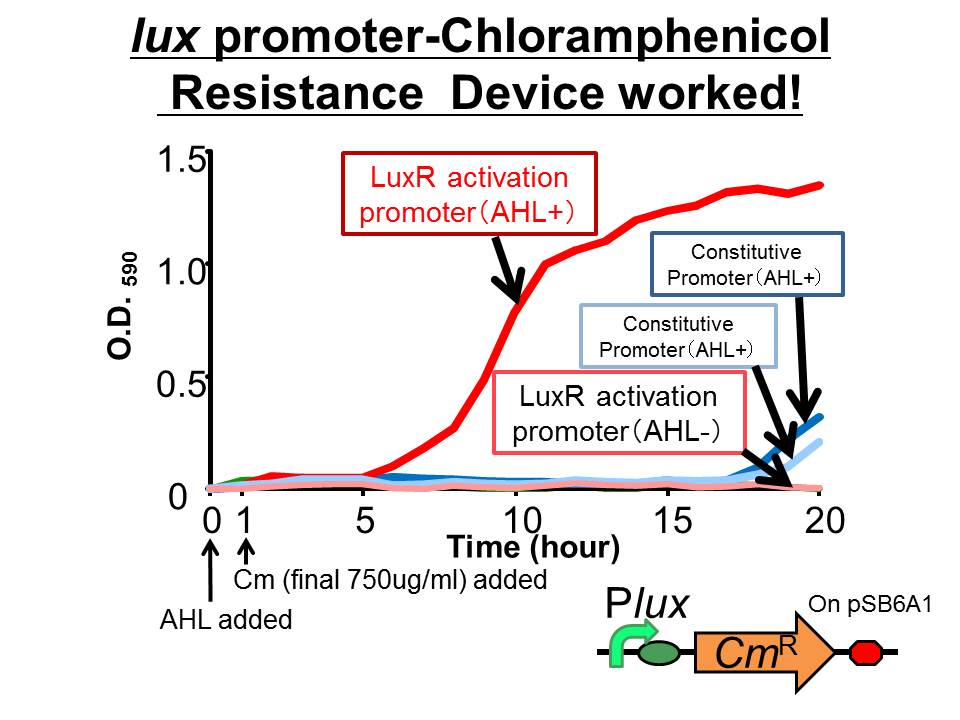Team:Tokyo Tech/Project/Artificial Cooperation System/Cm assay
From 2010.igem.org
| Line 8: | Line 8: | ||
<table id="table-01"> | <table id="table-01"> | ||
<tr> | <tr> | ||
| - | <td>[[Team:Tokyo_Tech|Graphical abstract]]<br> | + | <td>[[Team:Tokyo_Tech|1 Graphical abstract]]<br> |
</td> | </td> | ||
</tr> | </tr> | ||
Revision as of 13:53, 27 October 2010
3-2 resistance gene activation device
Contents |
Abstract
We succeeded in constructing and characterizing a NEW Biobrick device of chloramphenicol resistance (CmR) gene ([http://partsregistry.org/Part:BBa_K395162 BBa_K395162]) which is activated by lux promoter. We found that the device is activated by LuxR/3OC6HSL complex and that the cell introduced the part was able to survive even in high chloramphenicol concentration (750 ug/ml) in the presence of 3OC6HSL.
Introduction
In Artificial Cooperation System, the device that has CmR gene downstream of lux promoter (Plux-CmR) plays a crucial role. In synthetic biology, computing approach is a strong tool as well as wet work. We simulated our system. And the simulation shows this system is affected by many parameters. For example, 3OC6HSL concentration, chloramphenicol concentration, the interval of adding 3OC6HSL and chloramphenicol etc.
Our work in the previous page (characterization of promoter activated by LuxR/3OC6HSL) showed threshold concentration of 3OC6HSL. We searched the conditions when our cells are able to survive only in the presence of 3OC6HSL.
Results
- The results of 20 hours incubation after addition of chloramphenicol shows that Plux-CmR grew when 3OC6HSL is added ,while Plux-CmR in the absence of 3OC6HSL was not able to grow.
- In the case of the device that had constitutive promoter, the growth of the cells introduced the device were quite slow compared with that of Plux. However, there was no significant difference between in the presence and the absent of 3OC6HSL.
- The cells introduced the promoterless device were not able to grow independently of 3OC6HSL
Conclusion
From the results, when chloramphenicol was added, the cells introduced Plux-CmR were able to grow because LuxR/3OC6HSL complex activated Plux. This means we found the conditions that integrants were able to survive only in the presence of 3OC6HSL.
Material and Method
construction Plux-CmR on pSB6A1
A part, RBS-CmR was cut from BBa_P1004 by PCR and put into pSB6A1. Next RBS-CmR on pSB6A1 and Plux (BBa_R0062) was cut at EcoRI /Xba site and EcoRI/SpeI site respectively. Then we ligated two parts.
Construction of E. coli strain DH5α
Competent cells with luxR gene on pSB3K3 were constructed. Afterward, Plux-CmR on pSB6A1 was introduced into the cells.
The growth assay
In order to follow up the growth of the cells which Plux-CmR was introduced into, the change of O.D. (590nm) in both the presence and the absence of 3OC6HSL was measured.
(samples)
- Plux-CmR[http://partsregistry.org/Part:BBa_K395162 BBa_K395162]
- constitutive promoter (PlacIq)-CmR (positive control)[http://partsregistry.org/Part:BBa_K395165 BBa_K395165]
- promoterless-CmR (negative control)[http://partsregistry.org/Part:BBa_K395160 BBa_K395160]
LB medium were used for liquid culture. Antibiotics (ampicillin (Amp), kanamycin (Kan), and chloramphenicol (Cm)) were dissolved in distillation water and stored as 25 mg/ml, whose final concentration in the medium was 50ug/ml, 30ug/ml, and 750ug/ml respectively.
- The seed cultures of the samples were inoculated from glycerol stock solution and grown separately overnight at 37°C in LB medium containing Amp&Kan.
- Then, we diluted the cultures 100 folds by two types of 3 ml of fresh medium. One type of the medium contains 3OC6HSL (final concentration:100nM). Another contains DMSO as control. Both of the cultures were incubated at 37°C
- After 1 hour from dilution, each culture was separated to two new tubes. Then it was added 1.5 ml LB medium each containing Cm (final concentration:750ug/ml), Amp, Kan,3OC6HSL or DMSO
- Measured O.D.590 every an hour, up to 20 hours from dilution.
Reference
- Ying-jin Yuan et al PLoS 2010, e10619
- W. Shaw, et al Br. Med. Bull. 1984, 40, 36.
 "
"

